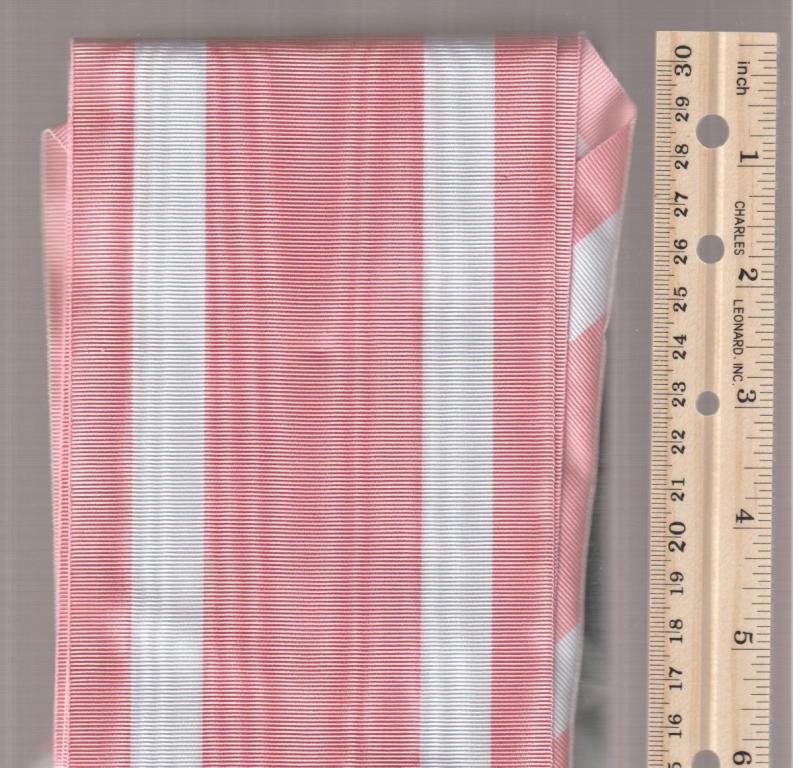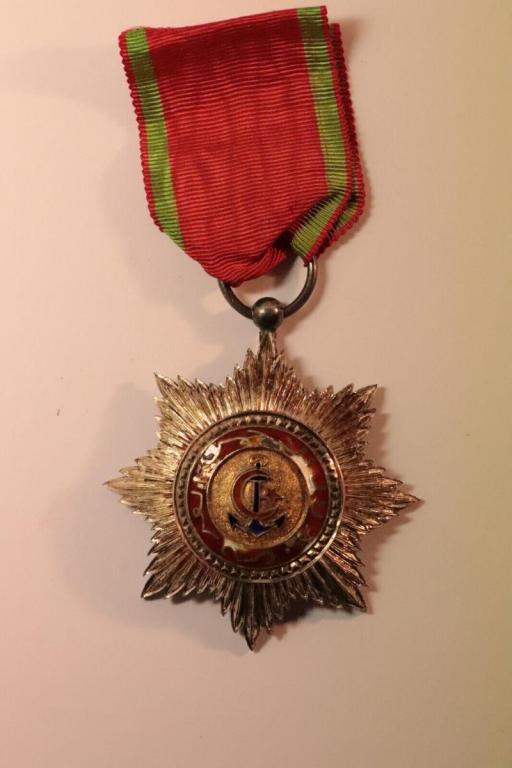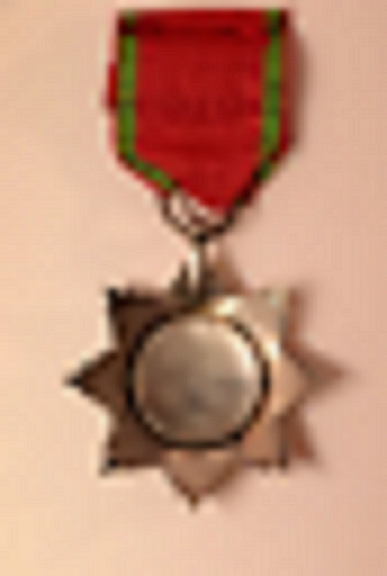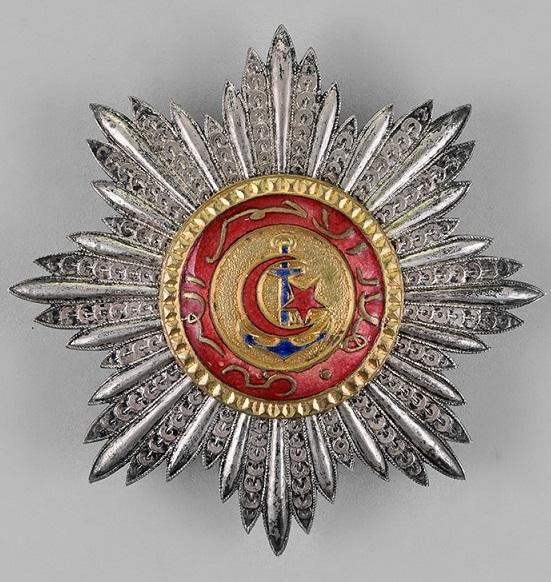
922F
Patron-
Posts
1,397 -
Joined
-
Last visited
-
Days Won
7
Content Type
Profiles
Forums
Blogs
Gallery
Events
Store
Everything posted by 922F
-
Question about the Order of Ismail/Nishan al-Ismail
922F replied to Rusty Greaves's topic in Middle East & Arab States
Rusty, Thank you for sharing this information. Hanafy's Lattes/Bichay chronology tracks well with what you have developed. Does Hanafy provide additional sources for his statements [business registrations, tax documents, etc.]? Cheers, EJ -
Sorry for late reply. This star was originally made and sold as a piece of costume jewelry, not with the intent of misleading buyers. So, don't know if 'fantasy medal' is an exactly correct term. Sometimes vendors try to pass Coro items off as actual award insignia, especially those modeled on the Ottoman Shefkat Order and the Royal Order of the Star of Anjouan. Ignorance or cupidity, who knows? . Actual award insignia do appear for sale with broach pins or jewelry suspensions added and original parts removed because people wanted to wear them as 'fashion accessories'. Others were altered by awardees themselves to make them easier to fasten to clothing or wear. This includes removing hinges, pins, pin catches and 'outriggers' from stars and replacing them with clutch back type pins or soldering or gluing movable suspensions so the item lacks articulation. Alterations may also have been motivated by an awardee's desire to replace specific symbols.
-
A piece of costume jewelry manufactured by the CORO firm. Coro, based in New York City, U.S.A., apparently bought a number of dies from French award makers [identified by some to include Delande and Baqueville] in the late 1940's-early 1950's. Coro used these and other of their own dies to produce a wide range of pieces in it's "Heraldic Line". Coro appears to have manufactured most "Heraldic Line" designs during the 1950's. At least four "international knightly orders" adopted Coro products as their insignia; Coro may have continued production of those through the 1960's. Some items within that line duplicated actual awards, sometimes even copying original enamel colors, but most combined several dies to create a novel design. Internet search will reveal variations created to be worn as pins, broaches, pendants, and so on. The most comprehensive study of this Coro product line may be found at https://www.omsa.org/forums/topic/coro-heraldic-line-medals/ That effort, however, does not include all types. Coro ceased business in 1979.
-
Neck badge appears to be a Tunisian Nichan Iftikhir [monogram in center & bow suspension] rather than Nichan el-Anouar [star in center & crown suspension]. I cannot clearly discern the monogram. If center monogram is "Ali", then likely an 1882-1902 bestowal. See https://asiamedals.info/threads/guide-for-dating-of-nichan-iftikhar-order-by-bey-monograms. for a guide to Beyical monograms compiled by one of our distinguished members. Keep in mind that exact correlation between monogram and period when person received this honor not always the case. Nichan Iftikhir awards do not necessarily signify service in Tunisia; Nichan el-Anouar usually recognized service in French Somaliland/Central Africa and elsewhere in France's Colonial Empire. Nichan Iftikhir much more widely awarded than Nichan el-Anouar. Perhaps this information will help identify your colonel.
-
Demir, The cross in the image seems to flare out at the ends in the style of Bulgarian National Merit [Civil & Military Divisions] Order insignia [type of Pisan Cross] but has no suspension crown so probably not one of those--too smallfor a commander badge anyway. Looks like there may be either a wreath or some sort of connection between the arms OR the cross is superimposed on a round base.. Sorry not to be of more help for the present.
-
Hello No One, Thank you again!! Yes, I checked with the IU archives. A personal visit would be required with no certainty of success in finding any information regarding decorations. It appears that a list of both Tubman's and Tolbert's awards existed at one time in their personal and Liberian official records. However, those appear to be 'missing'. I know that both Tubman's & Tolbert's homes/museums were severely looted many times after Tolbert's execution and that some of their awards were sold 'on the street' as early as 1989 thru 1990. Based on both your news and my own impressions, it may be that rank one, grade B with number 430 set may have belonged to Tolbert, awarded during his tenure as foreign minister. The IU Tubman archive on-line presents images of Liberian dignitaries wearing various Orders and medals. I found none with Liberians wearing Order of the Brilliant Star [or any other Chinese] awards as yet. Thank you again for your help I will report any future findings here. All best regards!!
-
Hello No One. Sincere thanks for your excellent advice, in-depth research and fast reply! I still try to find if and when Liberian Presidents received the Order as that may be a key to the number 430 set. High level ROC delegations visited Liberia in the early and mid-1950's and also at least in 1964, 1969 and 1970. These dates would indicate Tubman as president but do not answer why the insignia has an all purple sash. I will post any further findings. In your opinion, would this third level honor be appropriate for a head of state in the 1950's-1970's? It may be that a Liberian president would receive a higher grade. Possibly Liberian Vice-President/acting Foreign Minister Tolbert under Tubman received number 430. The Republic of Korea, for example, awarded the first class Order of Diplomatic Service Merit [Grand Gwanghwa] to him around 1968. All best regards!
-
Hello No One, Thank you for your clear descriptions. Have you been able to find a list of the names of persons awarded the order that includes the number stamped on the insignia? Could you confirm that the ribbon color would be all purple before early 1950's for all classes/grades of the Order? To include rank one, grade B? Example of rank one, grade B with number 430 has purple only sash & rank one, grade B with number 495 also has purple only sash but without usual rosette & European type bow [replacement sash?]. Number 430 attributed to President of Liberia [probably William V. S. Tubman {president 1944-1971, less likely William Tolbert {president 1971-1980}]. Number 495, probably given to unknown foreign person. Sincere regards and thanks for your help!
-
Order of the Crown with Swords
922F replied to LuckySlevin's topic in Central & Eastern European States
Looks like his Stanislaus lost an [upper left as viewed] eagle too! Appears his awards are attached to uniform using the so-called loop over cord method. Does anyone know this officer's history? -
Interesting photographs of decorated people
922F replied to ilieff's topic in Central & Eastern European States
Kisimov certainly looks the part of an actor!!! Soulful expression, arm akimbo, necktie worn with wing collar, and outward bow of his tie below the knot says it all--not to mention his two Laureates of the Dimitrov Prize awards! -
Great trio, Owain--centers may migrate, enamel ribbons not so much. Often crown shape or type indicative but not always.
-
Fascinating!!
-
Wonderful images; even better to have them all in one place! Thank you, gentlemen!!
-
Imperial Order of the Rose
922F replied to lambert's topic in Rest of the World: Militaria & History
Have about 20 meters of synthetic sash ribbon apparently made in the past 10 years for Da Costa or other makers of modern insignia. Note ribbon edges [chain stitch not warp/weft]. Anyone wanting to buy some [about 2.5 to 3 meters generally adequate to make a sash] kindly contact me. -
An impressive man, story, and display plus outstanding collaboration!
-
First ran across this award about 5 years ago. A manager of the "Peoples Self-Help Group", an international voluntary organization engaged in rebuilding water supply systems in Montserrado County, Liberia supposedly received it from then-President Sirleaf in 2017. Insignia exhibits design element common to other official Liberian medals [though with a larger planchet] and is accompanied by a document [seen above]. Inquiries in Monrovia and to three Liberian embassy information offices revealed no information. Not clear whether it is an official Liberian state award, a quasi official honor or a token of appreciation by a private group. Besides people associated with established beneficial groups like the Red Cross, UNDP and so on, various military personnel who provide help or protection for infrastructure projects have received. Like, perhaps, the Nigerian Officer in first image above.
-
Insignia looks like those used by one of the various Ordre Milice Christ aka Militia of Jesus Christ and similar named entities or "revivals"--many internet sites [like http://www.laicos.va/content/laici/en/sezioni/associazioni/repertorio/milizia-di-gesu-cristo.html] refer. Most badges post 1950's are uniface base metal and varities include some with a longer lower arm. Ribbon sometimes plain black or 1/2 black 1/2 white.
-
Question about the Order of Ismail/Nishan al-Ismail
922F replied to Rusty Greaves's topic in Middle East & Arab States
Thanks for these posts, Rusty! Yes, Owain, sashes seem very hard to find--a couple of sets have what appear to be House and Merit Order of Peter Frederick Louis sashes--there's little but discernable difference. -
Thank you Demir! The badge and star corpus look similar to those of the Order of the Star of Anjouan--an award subsumed into the French colonial honor system and later incorporated by the Comore Republic. That might fit well with insignia design and manufacture by a French producer.
-
Could anyone identify the honor represented by the attached images? The usual sources do not appear to include it. Have seen it described by dealers as a 'superior' Ottoman naval award and [much less plausibly] as a sort of Medjidjie Order naval division. The suspension, badge corpus and motto ring obviously differ from Medjidjie exemplars. Insignia seen to date include apparent 5th, 4th [rosette on ribbon], 3rd [neck ribbon] class and an [orphan?] star. Just one 5th class piece included a Medjidjie type suspender. None had typical zig-zag test marks or other apparent manufacturer marks.
-
Look at item 325503912188 ribbon edges. Easily visable edge looks to be chain-stiched rather than warp & weft. Maybe that vendor means ribbon made in the 1990's? German origin ribbon above appears to be warp/weft construction so more appropriate with insignia manufacture compatable/contemporary terms. And...both seem to be similar green color shade. Make-it-yourself triangle ribbons with gromet & hook fastener is possible but several commercial providers [Austria, Croatia, etc.] can do it for a price.
-
Prince Ferdinand Commemorative medals
922F replied to Graf's topic in Coins & Commemorative Medallions
Quite useful, thank you Graf! Does it appear that the box black designs are lithographed or printed or, because the box is silver, niello work? -
Prince Ferdinand Commemorative medals
922F replied to Graf's topic in Coins & Commemorative Medallions
Graf, Thanks for additional images. Do you think that the cigarette manufacturer won a medal at the fair--cannot make out 2 words on the lid.




